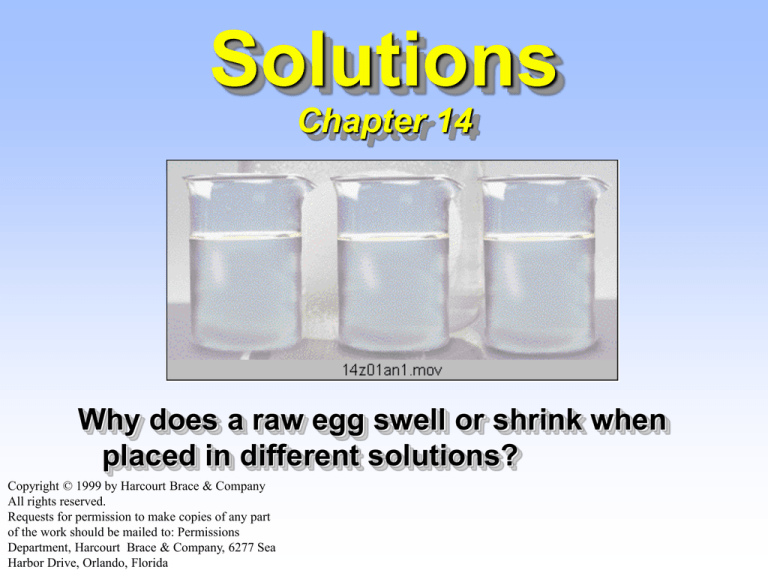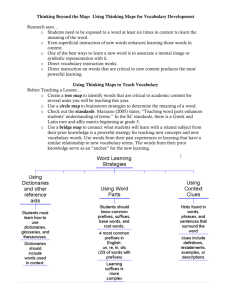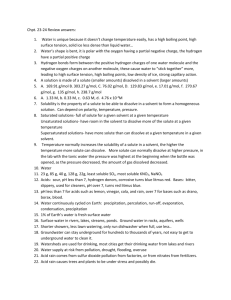
Solutions
Chapter 14
Why does a raw egg swell or shrink when
placed in different solutions?
Copyright © 1999 by Harcourt Brace & Company
All rights reserved.
Requests for permission to make copies of any part
of the work should be mailed to: Permissions
Department, Harcourt Brace & Company, 6277 Sea
Harbor Drive, Orlando, Florida
2
Some Definitions
A solution is a
HOMOGENEOUS
mixture of 2 or more
substances in a
single phase.
One constituent is
usually regarded as
the SOLVENT and
the others as
SOLUTES.
Copyright (c) 1999 by Harcourt Brace & Company
All rights reserved
Definitions
Solutions can be
classified as
unsaturated or
saturated.
Copyright (c) 1999 by Harcourt Brace & Company
All rights reserved
3
Definitions
Solutions can be
classified as
unsaturated or
saturated.
A saturated solution
contains the maximum
quantity of solute that
dissolves at that
temperature.
Copyright (c) 1999 by Harcourt Brace & Company
All rights reserved
4
Definitions
Solutions can be
classified as
unsaturated or
saturated.
A saturated solution
contains the maximum
quantity of solute that
dissovles at that
temperature.
SUPERSATURATED
SOLUTIONS contain
more than is possible
and are unstable.
Copyright (c) 1999 by Harcourt Brace & Company
All rights reserved
5
6
Energetics of the Solution
Process
If the enthalpy of
formation of the
solution is more
negative that that of
the solvent and
solute, the enthalpy
of solution is
negative.
The solution process
is exothermic!
Copyright (c) 1999 by Harcourt Brace & Company
All rights reserved
7
Supersaturated
Sodium Acetate
• One application of a
supersaturated
solution is the
sodium acetate
“heat pack.”
• Sodium acetate has
an ENDOthermic
heat of solution.
Copyright (c) 1999 by Harcourt Brace & Company
All rights reserved
8
Supersaturated
Sodium
Acetate
Sodium acetate has an ENDOthermic heat
of solution.
NaCH3CO2 (s) + heat ---->
Na+(aq) + CH3CO2-(aq)
Therefore, formation of solid sodium
acetate from its ions is EXOTHERMIC.
Na+(aq) + CH3CO2-(aq) --->
NaCH3CO2 (s) + heat
Copyright (c) 1999 by Harcourt Brace & Company
All rights reserved
Colligative Properties
On adding a solute to a solvent, the props. of
the solvent are modified.
• Vapor pressure
decreases
• Melting point
decreases
• Boiling point
increases
• Osmosis is possible (osmotic pressure)
These changes are called COLLIGATIVE
PROPERTIES.
They depend only on the NUMBER of solute
particles relative to solvent particles, not on
the KIND of solute particles.
Copyright (c) 1999 by Harcourt Brace & Company
All rights reserved
9
10
Concentration Units
An IDEAL SOLUTION is
one where the properties
depend only on the
concentration of solute.
Need conc. units to tell us the
number of solute particles
per solvent particle.
The unit “molarity” does not
do this!
Copyright (c) 1999 by Harcourt Brace & Company
All rights reserved
11
Concentration Units
MOLE FRACTION, X
For a mixture of A, B, and C
mol A
X A mol fraction A =
mol A + mol B + mol C
Copyright (c) 1999 by Harcourt Brace & Company
All rights reserved
12
Concentration Units
MOLE FRACTION, X
For a mixture of A, B, and C
mol A
X A mol fraction A =
mol A + mol B + mol C
MOLALITY, m
mol solute
m of solute =
kilograms solvent
Copyright (c) 1999 by Harcourt Brace & Company
All rights reserved
13
Concentration Units
MOLE FRACTION, X
For a mixture of A, B, and C
mol A
X A mol fraction A =
mol A + mol B + mol C
MOLALITY, m
mol solute
m of solute =
kilograms solvent
WEIGHT % = grams solute per 100 g solution
Copyright (c) 1999 by Harcourt Brace & Company
All rights reserved
Calculating Concentrations
Dissolve 62.1 g (1.00 mol) of ethylene glycol
in 250. g of H2O. Calculate mol fraction,
molality, and weight % of glycol.
Copyright (c) 1999 by Harcourt Brace & Company
All rights reserved
14
Calculating Concentrations
Dissolve 62.1 g (1.00 mol) of ethylene glycol in 250. g
of H2O. Calculate X, m, and % of glycol.
250. g H2O = 13.9 mol
Copyright (c) 1999 by Harcourt Brace & Company
All rights reserved
15
Calculating Concentrations
Dissolve 62.1 g (1.00 mol) of ethylene glycol in 250. g
of H2O. Calculate X, m, and % of glycol.
250. g H2O = 13.9 mol
1.00 mol glycol
X glycol =
1.00 mol glycol + 13.9 mol H2O
X glycol = 0.0672
Copyright (c) 1999 by Harcourt Brace & Company
All rights reserved
16
Calculating Concentrations
Dissolve 62.1 g (1.00 mol) of ethylene glycol in 250. g
of H2O. Calculate X, m, and % of glycol.
Calculate molality
1.00 mol glycol
conc (molality) =
4.00 molal
0.250 kg H2O
Copyright (c) 1999 by Harcourt Brace & Company
All rights reserved
17
Calculating Concentrations
Dissolve 62.1 g (1.00 mol) of ethylene glycol in 250. g
of H2O. Calculate X, m, and % of glycol.
Calculate molality
1.00 mol glycol
conc (molality) =
4.00 molal
0.250 kg H2O
Calculate weight %
62.1 g
%glycol =
x 100% = 19.9%
62.1 g + 250. g
Copyright (c) 1999 by Harcourt Brace & Company
All rights reserved
18
Dissolving Gases &
Henry’s Law
Gas solubility (M) = kH • Pgas
kH for O2 = 1.66 x 10-6 M/mmHg
When Pgas drops, solubility drops.
Copyright (c) 1999 by Harcourt Brace & Company
All rights reserved
19
20
Lake Nyos, Cameroon
Courtesy of George Kling, page 656-657
Copyright (c) 1999 by Harcourt Brace & Company
All rights reserved
21
Understanding
Colligative Properties
O
—
H
H—O
H
Copyright (c) 1999 by Harcourt Brace & Company
All rights reserved
H
To understand colligative properties, study
the LIQUID-VAPOR EQUILIBRIUM for a
solution.
surface
H—O
H
H
H—O
H—O
H
Understanding
Colligative Properties
To understand
colligative
properties,
study the
LIQUIDVAPOR
EQUILIBRIUM
for a solution.
Copyright (c) 1999 by Harcourt Brace & Company
All rights reserved
22
Understanding
Colligative Properties
VP of H2O over a solution depends on the
number of H2O molecules per solute
molecule.
Psolvent proportional to Xsolvent
OR
Psolvent = Xsolvent • Posolvent
VP of solvent over solution =
(Mol frac solvent)•(VP pure solvent)
RAOULT’S LAW
Copyright (c) 1999 by Harcourt Brace & Company
All rights reserved
23
Raoult’s Law
An ideal solution is one that obeys Raoult’s
law.
PA = XA • PoA
Because mole fraction of solvent, XA, is
always less than 1, then PA is always less
than PoA.
The vapor pressure of solvent over a solution
is always LOWERED!
Copyright (c) 1999 by Harcourt Brace & Company
All rights reserved
24
Raoult’s Law
Assume the solution containing 62.1 g of
glycol in 250. g of water is ideal. What is the
vapor pressure of water over the solution at
30 oC? (The VP of pure H2O is 31.8 mm Hg;
see App. E.)
Solution
Xglycol = 0.0672 and so Xwater = ?
Because Xglycol + Xwater = 1
Xwater = 1.000 - 0.0672 = 0.9328
Pwater = Xwater • Powater = (0.9382)(31.8 mm Hg)
Pwater = 29.7 mm Hg
Copyright (c) 1999 by Harcourt Brace & Company
All rights reserved
25
Raoult’s Law
For a 2-component system where A is the
solvent and B is the solute
DPA = VP lowering = XBPoA
VP lowering is proportional to mol frac solute!
For very dilute solutions, DPA = K•molalityB
where K is a proportionality constant.
This helps explain changes in melting and
boiling points.
Copyright (c) 1999 by Harcourt Brace & Company
All rights reserved
26
Changes in Freezing and
Boiling Points of Solvent
VP Pure solvent
1 atm
VP solvent
after adding
solute
P
BP solution
BP pure
solvent
Copyright (c) 1999 by Harcourt Brace & Company
All rights reserved
T
See Figure 14.13
27
28
The boiling point of a
solution is higher than that
of the pure solvent.
Copyright (c) 1999 by Harcourt Brace & Company
All rights reserved
29
Elevation of Boiling Point
Elevation in BP =
DtBP
= KBP • m
(where KBP is characteristic of solvent)
VP Pure solvent
1 atm
VP solvent
after adding
solute
P
BP solution
BP pure
solvent
Copyright (c) 1999 by Harcourt Brace & Company
All rights reserved
T
Change in Boiling Point
Dissolve 62.1 g of glycol (1.00 mol) in 250. g
of water. What is the BP of the solution?
KBP = +0.512 oC/molal for water (see Table
14.3).
Solution
1.
Calculate solution molality = 4.00 m
2.
DtBP = KBP • m
DtBP = +0.512 oC/molal (4.00 molal)
DtBP = +2.05 oC
BP = 102.05 oC
Copyright (c) 1999 by Harcourt Brace & Company
All rights reserved
30
31
Change in Freezing Point
Pure water
Ethylene glycol/water
solution
The freezing point of a solution is
LOWER than that of the pure solvent.
FP depression = DtFP = KFP•m
Copyright (c) 1999 by Harcourt Brace & Company
All rights reserved
Freezing Point Depression
Consider equilibrium at melting point
Liquid solvent <------> Solid solvent
• Rate at which molecules go from S to L
depends only on the nature of the solid.
• BUT — rate for L ---> S depends on how
much is dissolved. This rate is SLOWED for
the same reason VP is lowered.
• Therefore, to bring S ---> L and L ---> S rates
into equilibrium for a solution, T must be
lowered.
Thus, FP for solution < FP for solvent
FP depression = DtFP = KFP•m
Copyright (c) 1999 by Harcourt Brace & Company
All rights reserved
32
Freezing Point Depression
Calculate the FP of a 4.00 molal glycol/water
solution.
KFP = -1.86 oC/molal (Table 14.4)
Solution
DtFP = KFP • m
= (-1.86 oC/molal)(4.00 m)
DtFP = -7.44 oC
Copyright (c) 1999 by Harcourt Brace & Company
All rights reserved
33
Freezing Point Depression
How much NaCl must be dissolved in 4.00
kg of water to lower FP to -10.00 oC?.
Solution
Calc. required molality
DtFP = KFP • m
-10.00 oC = (-1.86 oC/molal) • Conc
Conc = 5.38 molal
Copyright (c) 1999 by Harcourt Brace & Company
All rights reserved
34
Freezing Point Depression
How much NaCl must be dissolved in 4.00 kg of water to lower
FP to -10.00 oC?.
Solution
Conc req’d = 5.38 molal
This means we need 5.38 mol of dissolved
particles per kg of solvent.
Recognize that m represents the total conc.
of all dissolved particles.
Recall that 1 mol NaCl(aq)
--> 1 mol Na+(aq) + 1 mol Cl-(aq)
Copyright (c) 1999 by Harcourt Brace & Company
All rights reserved
35
Freezing Point Depression
How much NaCl must be dissolved in 4.00 kg of water to lower
FP to -10.00 oC?.
Solution
Conc req’d = 5.38 molal
We need 5.38 mol of dissolved particles per
kg of solvent.
NaCl(aq) --> Na+(aq) + Cl-(aq)
To get 5.38 mol/kg of particles we need
5.38 mol / 2 = 2.69 mol NaCl / kg
2.69 mol NaCl / kg ---> 157 g NaCl / kg
(157 g NaCl / kg)•(4.00 kg) = 629 g NaCl
Copyright (c) 1999 by Harcourt Brace & Company
All rights reserved
36
37
Boiling Point Elevation and
Freezing Point Depression
Dt
= K•m•i
A generally useful equation
i = van’t Hoff factor = number of particles
produced per formula unit.
Compound
Theoretical Value of i
glycol
1
NaCl
2
CaCl2
3
Copyright (c) 1999 by Harcourt Brace & Company
All rights reserved
38
Osmosis
Copyright (c) 1999 by Harcourt Brace & Company
All rights reserved
Osmosis
Solvent
Solution
Semipermeable membrane
The semipermeable membrane should
allow only the movement of solvent
molecules.
Therefore, solvent molecules move from
pure solvent to solution.
Copyright (c) 1999 by Harcourt Brace & Company
All rights reserved
39
40
Osmosis
Osmotic
Pressure
Solvent
Solution
The semipermeable membrane should
allow only the movement of solvent
molecules.
Therefore, solvent molecules move from
pure solvent to solution.
Copyright (c) 1999 by Harcourt Brace & Company
All rights reserved
41
Osmosis
Osmotic
Pressure
Solvent
Solution
Equilibrium is reached when pressure
produced by extra solution —
the OSMOTIC PRESSURE, p
p = cRT (where c is conc. in mol/L)
counterbalances pressure of solvent
molecules moving thru the membrane.
Copyright (c) 1999 by Harcourt Brace & Company
All rights reserved
42
Osmosis
Copyright (c) 1999 by Harcourt Brace & Company
All rights reserved
43
Osmosis
• Osmosis of solvent
from one solution to
another can continue
until the solutions are
ISOTONIC — they
have the same
concentration.
• Osmotic pressure in
living systems:
FIGURE 14.16
Copyright (c) 1999 by Harcourt Brace & Company
All rights reserved
Osmosis
Calculating a Molar Mass
Dissolve 35.0 g of hemoglobin in enough water
to make 1.00 L of solution. p measured to be
10.0 mm Hg at 25 C. Calc. molar mass of
hemoglobin.
Solution
(a)
Calc. p in atmospheres
p = 10.0 mmHg • (1 atm / 760 mmHg)
(b)
= 0.0132 atm
Calc. concentration
Copyright (c) 1999 by Harcourt Brace & Company
All rights reserved
44
Osmosis
Calculating a Molar Mass
Dissolve 35.0 g of hemoglobin in enough water to make 1.00 L
of solution. p measured to be 10.0 mm Hg at 25 C. Calc.
molar mass of hemoglobin.
Solution
Calc. concentration from p = cRT
0.0132 atm
Conc =
(0.0821 L • atm/K • mol)(298K)
(b)
Copyright (c) 1999 by Harcourt Brace & Company
All rights reserved
45
Osmosis
Calculating a Molar Mass
Dissolve 35.0 g of hemoglobin in enough water to make 1.00 L
of solution. p measured to be 10.0 mm Hg at 25 C. Calc.
molar mass of hemoglobin.
Solution
Calc. concentration from p = cRT
0.0132 atm
Conc =
(0.0821 L • atm/K • mol)(298K)
(b)
(c)
Conc = 5.39 x 10-4 mol/L
Calc. molar mass
Molar mass = 35.0 g / 5.39 x 10-4 mol/L
Molar mass = 65,100 g/mol
Copyright (c) 1999 by Harcourt Brace & Company
All rights reserved
46







